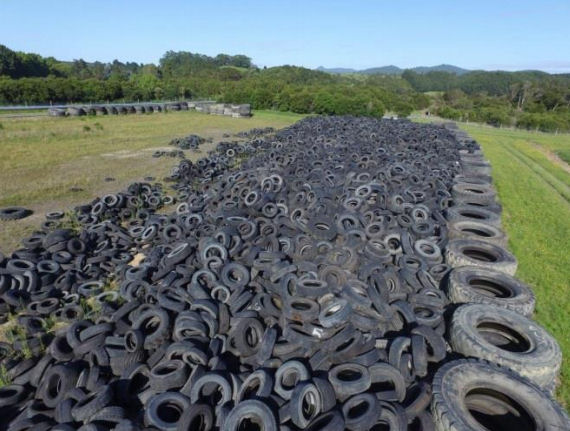New Zealand proposes waste tyre standard, invests in cement fuel project
 Abandoned stockpiles of tyres is a reoccurring problem in New Zealand; this one is in Kawerau, Bay of Plenty
Abandoned stockpiles of tyres is a reoccurring problem in New Zealand; this one is in Kawerau, Bay of Plenty
New Zealand is a country of 4.6 million people, and every year this country of 4.6 million generates around five million waste tyres. At present, no national regulations are in place to manage the outdoor storage of tyres, and the need for public authorities to deal with abandoned stockpiles of tyres is a reoccurring problem. The New Zealand government intends to get serious about waste tyres and has released a consultation document outlining a proposed National Environmental Standard.
According to Dr Nick Smith, New Zealand’s Minister for the Environment, the standard aims to establish a nationwide collection and shredding operation and provides a large-scale end use by installing technology for using waste tyres in cement manufacture. Measures set out in the consultation document also include a banning of outdoor tyre stockpiles of 200 cubic metres or more – the equivalent of some 2,500 passenger car tyres, loosely stacked – without council consent.
“The intention behind this proposed regulation is to also drive the tyre industry towards more sustainable recycling and disposal options,” Smith explained. “As part of this package, funding from the Government’s Waste Minimisation Fund (WMF) is being provided towards a significant investment in infrastructure with the waste industry to collect and shred end-of-life tyres. A funding arrangement has also been entered into with Golden Bay Cement to install machinery to enable millions of tyres per year to be used in the manufacture of cement. WMF funding is also being provided to other potential end-of-life tyre uses such as in road and cycleway surfacing, floor underlay, fuel and construction products.”
Smith reports that the New Zealand government has provided a grant of NZ$3.8 million (£2.2 million) for the establishment of a nationwide tyre collection network and tyre shredding facilities in the cities of Auckland and Christchurch; these projects involve a capital investment of $6.4 million. The shredding machinery will be imported this year, operational in Auckland by the end of 2017 and in Christchurch in 2018.
A grant of $13.6 million has been given to Golden Bay Cement towards the $18.1 million cost of new equipment that is expected to dispose of 3.1 million shredded tyres per year. “This technology is globally one of the most common and economically viable solutions to waste tyres,” comments Nick Smith. “The high temperature incineration minimises pollutants, the steel in the tyres contributes to the iron requirements of cement and the rubber provides a fuel substitute for coal.” It is estimated that the substitution of rubber biofuel for coal will reduce emissions at the Golden Bay Cement site by 13,000 tonnes per year.
“We are also providing grants of $1.2 million to another seven smaller tyre waste projects,” the Environment Minister continues. “These government grants of $19 million (£10.9 million) will enable $28 million of investment into tyre waste solutions. Combined with the new regulations restricting stockpiling, these measures will go a huge way towards a sustainable solution to New Zealand’s end of life tyre problem.”
The proposed National Environmental Standard could enter effect by mid-2018. Submissions regarding the consultation document are being accepted until 4 August 2017. The document can be downloaded here.




Comments